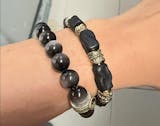Buddhist Bracelets: From Ancient Tradition to Modern Spiritual Tool
Introduction
Buddhist bracelets have become increasingly popular in recent years, not only as fashion accessories but also as meaningful symbols of spiritual practice and personal growth. This article explores the history, symbolism, types, and benefits of Buddhist bracelets, providing insights for those interested in incorporating these powerful tools into their spiritual journey.

The Origins and History of Buddhist Bracelets
Buddhist bracelets, also known as mala bracelets or prayer beads, have a rich history dating back thousands of years. Originally used in India, these spiritual tools spread throughout Asia with the expansion of Buddhism.
Ancient Roots
The origins of Buddhist bracelets can be traced back to ancient India, where they were first utilized by Hindu ascetics. Over 3,000 years ago, these beads served as counting tools for mantras and prayers during meditation. The practice allowed individuals to keep track of their recitations without losing focus on their spiritual intentions.
Evolution and Spread
As Buddhism expanded from India to other regions such as Tibet, China, and Japan, the use of prayer beads evolved. Each culture adapted the mala to fit its unique spiritual practices and beliefs. For instance, Tibetan Buddhists often use malas made from specific materials believed to enhance meditation and spiritual connection.In the 20th century, Buddhist bracelets began gaining popularity in Western cultures. This shift was fueled by the growing interest in mindfulness practices and spirituality among individuals seeking alternative paths to personal growth. Today, these bracelets are embraced not only for their spiritual significance but also for their aesthetic appeal.

Symbolism and Meaning of Buddhist Bracelets
Buddhist bracelets are rich in symbolism, with each component carrying deep spiritual significance that enhances their use in meditation and daily life.
Number of Beads
Traditional malas typically consist of 108 beads. This number is significant in Buddhist philosophy as it represents the 108 earthly desires that one must overcome to achieve enlightenment. Each bead serves as a reminder of these desires during meditation. In contrast, wrist malas often have fewer beads—21 or 27—allowing for easier daily wear while still maintaining a connection to the original mala's purpose.
Materials and Colors
The materials used in crafting Buddhist bracelets also hold symbolic meanings:- Wood: Commonly used materials include sandalwood and rosewood. Sandalwood is known for its calming properties and pleasant aroma, making it ideal for meditation.
-
Gemstones: Different gemstones are chosen based on their unique properties. For example:
- Amethyst: Associated with spiritual growth and clarity.
- Jade: Represents harmony and balance.
- Lapis Lazuli: Known for enhancing wisdom and self-awareness.
-
Colors: The color of the beads can also carry meaning. For example:
- Red: Symbolizes strength and protection.
- Blue: Represents wisdom and tranquility.
- Green: Associated with healing and renewal.

Types of Buddhist Bracelets
Buddhist bracelets come in various styles, each with its own unique characteristics and uses that cater to different preferences and practices.
Traditional Mala Bracelets
Traditional mala bracelets typically feature 108 beads made from wood or gemstones. These are designed primarily for meditation purposes. Practitioners use them to count mantras during meditation sessions. Many traditional malas also include a tassel at the end, symbolizing enlightenment or spiritual awakening.
Wrist Malas
Wrist malas are smaller versions that usually contain 21 or 27 beads. They are designed for everyday wear while still serving as tools for mindfulness. Wrist malas allow individuals to carry their spiritual practice into daily life without needing to engage in formal meditation sessions.
Charm Bracelets
Some modern interpretations incorporate Buddhist symbols like the Buddha, lotus flower, or Om symbol into charm bracelets. These pieces blend spirituality with contemporary design aesthetics, making them appealing to those who want to express their beliefs through fashion.
Customized Bracelets
Many artisans offer customized Buddhist bracelets that allow wearers to choose specific materials, colors, and symbols based on their personal beliefs or intentions. This customization can enhance the bracelet's significance to the wearer, creating a deeply personal spiritual tool.Choosing the right type of Buddhist bracelet depends on individual preferences regarding style, intended use, and personal connection to spirituality.

Benefits and Uses of Buddhist Bracelets
Wearing a Buddhist bracelet can offer numerous benefits that extend beyond mere aesthetics:
Spiritual Benefits
- Mindfulness: Wearing a Buddhist bracelet serves as a constant reminder to stay present throughout daily activities.
- Meditation Aid: These bracelets help practitioners count mantras during meditation sessions, enhancing focus and concentration.
- Spiritual Connection: Wearing a mala fosters a deeper link to Buddhist teachings and traditions, encouraging personal growth.
Practical Benefits
- Stress Relief: The act of touching and moving the beads can be calming during stressful situations.
- Personal Growth: Regular use encourages self-reflection and positive habits that contribute to emotional well-being.
- Fashion Statement: Beyond their spiritual significance, many people wear these bracelets as stylish accessories that express their interests in spirituality or mindfulness.

How to Use a Buddhist Bracelet
- Choose an Intention: Before wearing your bracelet or using it for meditation, choose an intention or mantra that resonates with you.
- Hold the Bracelet: Use your right hand to hold the bracelet while you recite your chosen mantra.
- Count Through Each Bead: Start at the guru bead and move through each bead as you recite your mantra until you return to the guru bead.
- Complete One Full Round: Completing one full round symbolizes fulfillment of your intention or prayer.
Regular use of a Buddhist bracelet can deepen one's spiritual practice while bringing peace and clarity into daily life.
Conclusion
Buddhist bracelets are more than just beautiful accessories; they are powerful tools for spiritual growth, mindfulness, and personal transformation. By understanding their history, symbolism, types, and benefits, individuals can harness the full potential of these sacred objects in their own lives.Whether you're a dedicated practitioner or someone seeking greater peace through mindfulness practices, a Buddhist bracelet can be a meaningful addition to your journey toward self-discovery and enlightenment. Embrace these ancient symbols as reminders of your path toward inner peace and compassion.
Related articles:
How to Use Buddhist Prayer Beads for Meditation
The Benefits of Wearing a Buddhist Mantra Bracelets
The Spiritual Significance of Buddhist Monk Bracelets and Buddha Beads
Step-by-Step Guide: How to Meditate Using Buddhist Prayer Beads

























































